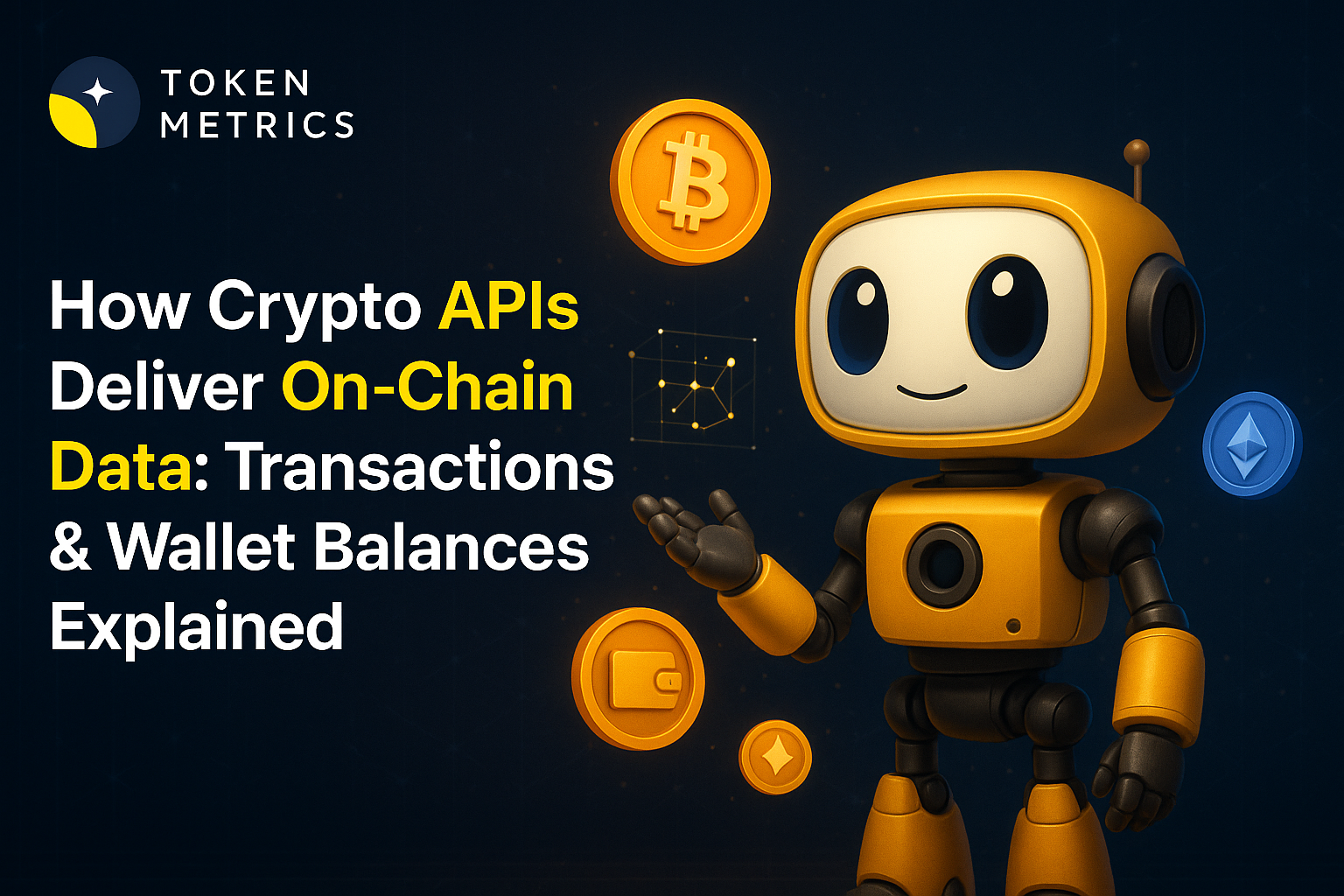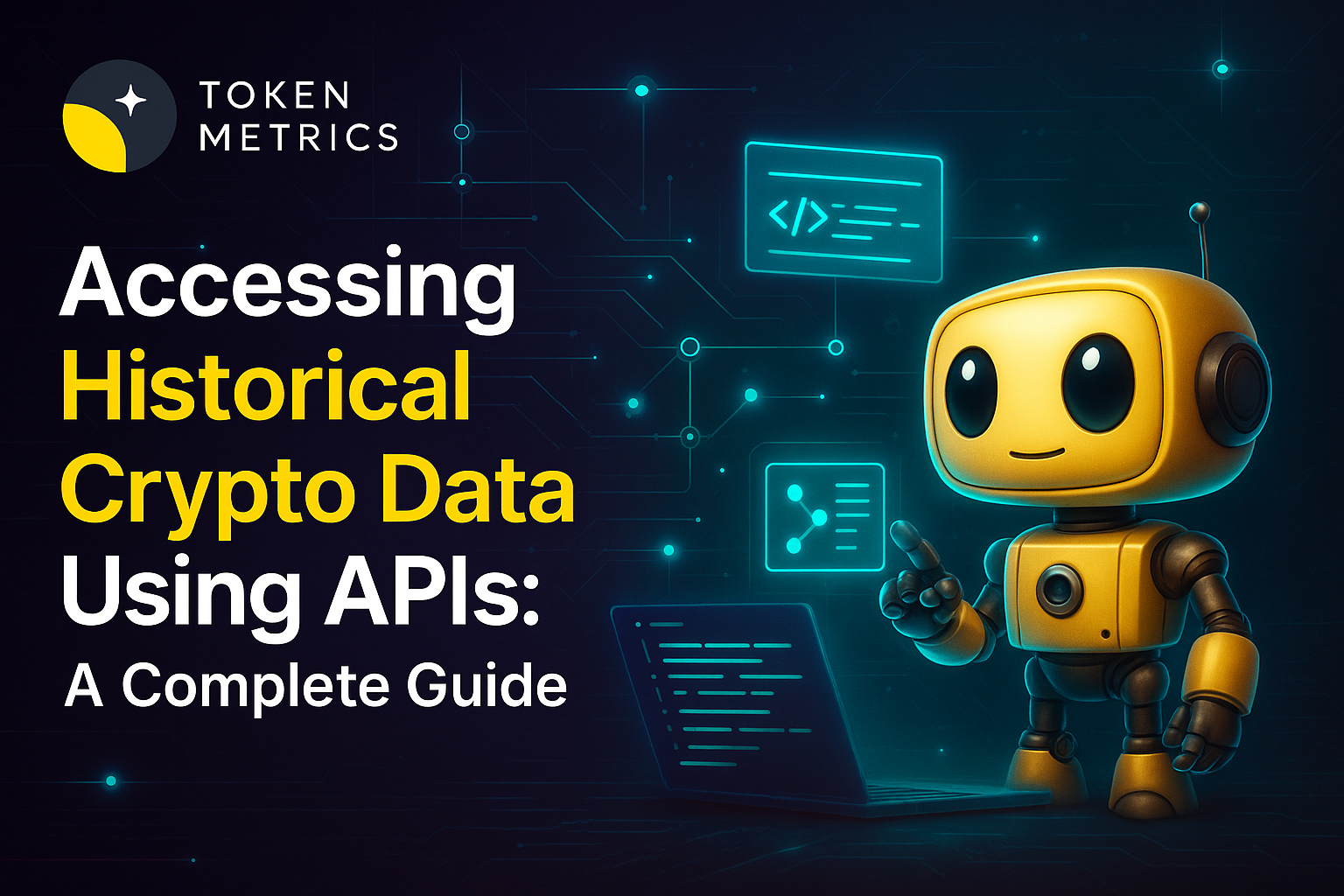
Generating Passive Income with Token Metrics AI Indices: Beyond Capital Appreciation to Consistent Yield

The landscape of cryptocurrency investing is changing. For many years, the focus remained solely on speculation and price appreciation—the legendary 'number go up' mindset.
Now, innovative protocols and platforms are turning crypto into an income-generating asset class, creating new opportunities for systematic, sustainable yield. Understanding this shift is crucial for anyone seeking more than just capital gains from their crypto portfolios.
Understanding Cryptocurrency Passive Income Sources
Staking is one primary way to earn crypto income. It involves locking up tokens to support a blockchain network's operation and security.
Stakers receive newly minted tokens in return, with yields depending on each network.
Major stakable cryptocurrencies include:
• Ethereum (post-Merge), yielding roughly 3-5% annually
• Cardano (ADA), with 4-6% rewards
• Solana (SOL), at 6-8% yields
• Polkadot (DOT), returning 10-14%
• Cosmos (ATOM), providing 15-20% rewards
Staking provides predictable returns and aligns incentives for network security. There’s also no risk of impermanent loss, unlike liquidity provision.
However, stakers face lock-up periods, possible slashing due to validator misbehavior, and variable yields based on participation rates.
For DeFi lending, platforms like Aave, Compound, and MakerDAO allow crypto holders to lend tokens, earning interest like a traditional bond.
Stablecoins typically generate 2-8% annually, while more volatile assets could see 1-4%, climbing higher during periods of high demand.
Flexible liquidity, diversified asset options, and auto-reinvesting are benefits. Risks include smart contract vulnerabilities, liquidity crunches, and protocol insolvency.
Liquidity provision lets users earn trading fees for supplying pairs to AMMs such as Uniswap, SushiSwap, or PancakeSwap.
Major trading pairs could earn 5-20% annually, but more exotic token pools might offer far higher returns—alongside greater risks.
The largest risk is impermanent loss, which can sometimes outpace fee earnings during high volatility.
Yield aggregators (like Yearn Finance) enable hands-off income by algorithmically finding the highest DeFi yields and managing strategies on users' behalf.
This brings optimization and gas savings but also adds further smart contract risk and possible tax complexity.
Building a Passive Income Strategy with Token Metrics
Constructing an income-oriented portfolio means balancing yield generation, capital preservation, and growth.
A typical allocation through Token Metrics might use 40-50% in staking assets (such as ETH, ADA, SOL, DOT), 30-40% in stablecoin lending, 10-20% in liquidity provision, and a modest 0-10% in higher-risk yield farming.
This strategy emphasizes stability and sustainability while still benefiting from capital gains and yield variety.
Yield stacking is a tactic where investors combine multiple yield streams from a single holding, such as staking ETH, then lending staked ETH derivatives for an added yield layer.
This can boost total income but may add complexity or stacked risk, so each layer should be carefully evaluated.
Sustainable yields are derived from real economic activity. In contrast, 'unsustainable' yields are often backed only by new token issuance, which can erode value over time.
Token Metrics AI distinguishes between these by analyzing protocol revenues, yield sources, and token supply dynamics.
Risk Management for Income-Generating Strategies
Smart contract risk is inherent in DeFi income opportunities.
Token Metrics emphasizes diversification across multiple audited protocols, focusing on established providers, and monitoring for new vulnerabilities.
Even with robust precautions, only risk amounts you are prepared to lose entirely in DeFi protocols.
Counterparty and protocol risk also merit attention. Market disruptions can challenge protocol solvency, especially during periods of stress or volatile price swings.
Token Metrics mitigates these exposures by selecting over-collateralized protocols, monitoring reserve funds, managing exposure, and stress-testing scenarios.
Impermanent loss is a key risk for liquidity providers.
The platform favors strategies with highly correlated pairs, sustainable fee offsets, and appropriate allocation size to contain exposure.
Crypto income also brings complex tax obligations. Each yield event (staking, lending, fees) typically triggers a taxable moment, and detailed record-keeping is critical.
Get Started For Free
Token Metrics Indices for Income Generation
Large-Cap Staking Indices:
Token Metrics offers indices focused on leading Proof-of-Stake assets, blending potential appreciation with steady yields. These strategies spotlight established networks, optimize staking selections, and help manage liquidity and risk.
For income-oriented investors, these can provide stable 4-8% annual yields with less downside than purely growth-weighted options—but still more volatility than many traditional products.
DeFi Yield Indices:
Specifically designed to capture lending, liquidity, and aggregation yield opportunities, these indices diversify across protocols and systematically rebalance for optimal results.
They suit those comfortable with DeFi risks and desiring enhanced yield potential (10-20%+ in favorable markets).
Balanced Income and Growth Indices:
Balancing income generators with growth tokens, these indices typically split allocations—for example 60% in appreciation assets, 40% in income-producing holdings.
Moderate yields (3-7%) are common, combining growth upside and consistent cash flow.
Practical Implementation: From Strategy to Income
Calculating the yield required for income goals is a vital first step. For example, a $1,000,000 portfolio targeting $50,000 annual income requires a 5% yield, while a $500,000 portfolio would require an unsustainable 10%.
Staking can be approached through:
• Direct staking (most technical, highest yields)
• Delegated staking (third-party validators for ease)
• Liquid staking (protocols like Lido for flexibility)
Token Metrics provides tailored advice to optimize staking approach by asset, reflecting yields, lock-up, and user preferences.
Cash flow and reinvestment must be planned systematically—decide withdrawal frequency, reinvestment amounts, tax withholding, and rebalance as life stages shift.
Most investors reinvest during accumulation, then increase withdrawals for retirement or income phases. Token Metrics indices can adapt dynamic allocations accordingly.
Ongoing monitoring is essential. Quarterly reviews of protocol health, comparative yield checks, and timely rebalancing help maintain income sustainability.
Token Metrics’ analytics automate much of this ongoing assessment, flagging notable changes for user action.
Real-World Income Scenarios
Scenario 1 – Supplemental Income:
An employed professional with $300,000 in crypto seeks $1,000-$2,000 monthly and moderate risk. The strategy could include 60% large-cap staking, 30% stablecoin lending, and 10% conservative DeFi, targeting a blended 5-7% annual return.
Scenario 2 – Early Retirement:
A 50-year-old with $1,500,000 in crypto aims for $75,000 per year in five years, with moderate/aggressive risk. A balanced index (50%), DeFi yield index (30%), and large-cap staking (20%) could target a 6-8% yield, blended with capital withdrawals if necessary.
Scenario 3 – Financial Independence:
A 35-year-old with $750,000 targets future independence and a $100,000 annual income. Aggressive growth indices (70%) and DeFi yield indices (30%) may be optimal, directing all current income back into the portfolio for compounding.
Avoiding Passive Income Pitfalls
Chasing extremely high yields—especially anything above 100%—is the most common misstep among crypto income investors.
Token Metrics systematically screens out these unsustainable offers, instead prioritizing protocols delivering steady, real-economic yields within a safer range.
Focusing excessively on yield without regard to principal protection is another risk. A high yield does not compensate if the asset’s underlying value declines sharply. Total return—combining appreciation and income—is always the bigger picture.
DeFi risks are often correlated. What appears diversified may not truly diversify portfolio risk if protocols are tightly connected.
Token Metrics manages this by combining blockchains (e.g., Ethereum, Solana, Avalanche), different income methods, and balancing DeFi with non-DeFi assets for true diversification.
Building Sustainable Passive Income Through Intelligent Crypto Strategies
The maturation of crypto investing delivers new paths toward passive income, not just speculative growth. Thoughtful strategy and risk management are key.
Focus on yields from genuine activity, diversify smartly, and continuously revisit portfolio allocations as conditions change.
Token Metrics AI Indices offer systematic portfolio tools and research for pursuing income. The platform's AI filters opportunities by sustainability, automates complex allocations, and keeps investors informed about evolving protocols and industry risk.
Whether you aim for supplemental income, long-term wealth, or full financial independence, smart use of these tools now puts the future of passive crypto income within reach.
FAQ: Passive Income with Crypto Indices
What is the difference between staking and DeFi lending?
Staking means locking tokens to support a network and earn newly minted rewards, usually tied to Proof-of-Stake blockchains.
DeFi lending involves providing assets to protocols where borrowers pay interest. Staking supports network operations, while lending acts like digital banking for earners.
Are crypto passive income yields guaranteed?
No, crypto yields are never guaranteed.
Returns depend on protocol economics, market demand, and potential risks, including smart contract issues and overall market volatility.
How can Token Metrics help manage income risk?
Token Metrics evaluates and monitors thousands of protocols, rates their risk, analyzes yield sources, and helps users systematically diversify across many strategies to lessen risk.
What tax documentation does generating crypto income require?
Each yield event (staking, lending, liquidity provision) may trigger taxable income, which must be reported where required by law.
Keeping careful records and seeking guidance from a crypto-specialized tax expert is strongly advised.
Which income strategies are most sustainable?
Sustainable income derives from real network use like transaction fees, security rewards, or legitimate borrowing. The most sustainable avenues are usually staking on established blockchains and selectively vetted lending platforms.
Very high yields backed by token inflation, rather than real use, are generally less sustainable.
Get Started For Free
Disclaimer
This blog is for educational and informational purposes. It does not constitute financial, investment, or tax advice.
Cryptocurrency markets are volatile and carry risk. Always conduct your own due diligence and seek independent advice before acting on any information provided herein.

.svg)

Create Your Free Token Metrics Account

.png)




%201.svg)
%201.svg)


%201.svg)









.svg)




.png)